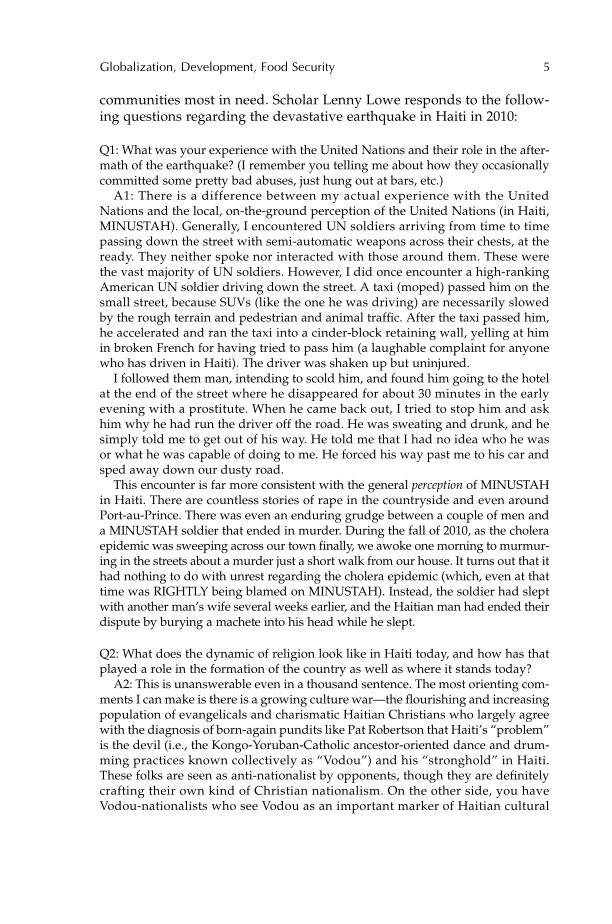communities most in need. Scholar Lenny Lowe responds to the follow- ing questions regarding the devastative earthquake in Haiti in 2010: Q1: What was your experience with the United Nations and their role in the after- math of the earthquake? (I remember you telling me about how they occasionally committed some pretty bad abuses, just hung out at bars, etc.) A1: There is a difference between my actual experience with the United Nations and the local, on-the-ground perception of the United Nations (in Haiti, MINUSTAH). Generally, I encountered UN soldiers arriving from time to time passing down the street with semi-automatic weapons across their chests, at the ready. They neither spoke nor interacted with those around them. These were the vast majority of UN soldiers. However, I did once encounter a high-ranking American UN soldier driving down the street. A taxi (moped) passed him on the small street, because SUVs (like the one he was driving) are necessarily slowed by the rough terrain and pedestrian and animal traffic. After the taxi passed him, he accelerated and ran the taxi into a cinder-block retaining wall, yelling at him in broken French for having tried to pass him (a laughable complaint for anyone who has driven in Haiti). The driver was shaken up but uninjured. I followed them man, intending to scold him, and found him going to the hotel at the end of the street where he disappeared for about 30 minutes in the early evening with a prostitute. When he came back out, I tried to stop him and ask him why he had run the driver off the road. He was sweating and drunk, and he simply told me to get out of his way. He told me that I had no idea who he was or what he was capable of doing to me. He forced his way past me to his car and sped away down our dusty road. This encounter is far more consistent with the general perception of MINUSTAH in Haiti. There are countless stories of rape in the countryside and even around Port-au-Prince. There was even an enduring grudge between a couple of men and a MINUSTAH soldier that ended in murder. During the fall of 2010, as the cholera epidemic was sweeping across our town finally, we awoke one morning to murmur- ing in the streets about a murder just a short walk from our house. It turns out that it had nothing to do with unrest regarding the cholera epidemic (which, even at that time was RIGHTLY being blamed on MINUSTAH). Instead, the soldier had slept with another man’s wife several weeks earlier, and the Haitian man had ended their dispute by burying a machete into his head while he slept. Q2: What does the dynamic of religion look like in Haiti today, and how has that played a role in the formation of the country as well as where it stands today? A2: This is unanswerable even in a thousand sentence. The most orienting com- ments I can make is there is a growing culture war—the flourishing and increasing population of evangelicals and charismatic Haitian Christians who largely agree with the diagnosis of born-again pundits like Pat Robertson that Haiti’s “problem” is the devil (i.e., the Kongo-Yoruban-Catholic ancestor-oriented dance and drum- ming practices known collectively as “Vodou”) and his “stronghold” in Haiti. These folks are seen as anti-nationalist by opponents, though they are definitely crafting their own kind of Christian nationalism. On the other side, you have Vodou-nationalists who see Vodou as an important marker of Haitian cultural Globalization, Development, Food Security 5
Document Details My Account Print multiple pages
Print
You have printed 0 times in the last 24 hours.
Your print count will reset on at .
You may print 0 more time(s) before then.
You may print a maximum of 0 pages at a time.








































































































































































































































